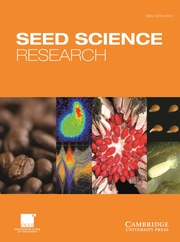Article contents
Mechanism of salt-inhibited early seed germination analysed by transcriptomic sequencing
Published online by Cambridge University Press: 04 March 2019
Abstract
Seed germination, the first and critical step of the plant's life cycle, is affected by salt stress. However, the underlying mechanism of salt tolerance during early seed germination remains elusive. Here, a comparative RNA-seq analysis was performed using early germinating seeds either under normal conditions or in 100 and 150 mM sodium chloride. A total of 575 genes were up-regulated and 913 genes were down-regulated in the presence of 100 mM NaCl. Under the 150 mM NaCl treatment 1921 genes were up-regulated and 3501 genes were down-regulated. A total of 379 or 863 genes were up-regulated or down-regulated in both 100 and 150mM NaCl. These co-regulated genes were further analysed by GO enrichment. Genes in the categories abscisic acid signaling and synthesis and nutrient reservoir activity were significantly enriched in the up-regulated genes. Transcription factors responsive to gibberellin and auxin were significantly down-regulated by salinity stress. Genes related to anti-oxidant activity were significantly enriched in the down-regulated gene clusters by NaCl treatment. Our results suggest that salt stress inhibits seed germination by activating ABA synthesis and signalling, and depressing GA and auxin signalling, while preserving nutrition and down-regulated anti-oxidant activity. Our study provides more insight into the molecular mechanism of salt tolerance during early seed germination.
Keywords
- Type
- Research Paper
- Information
- Copyright
- Copyright © Cambridge University Press 2019
References
- 4
- Cited by




